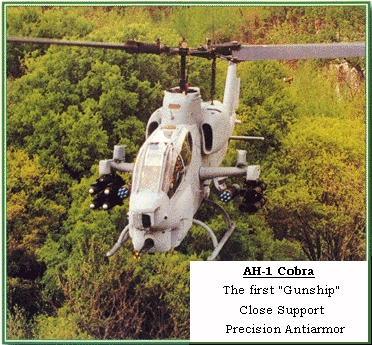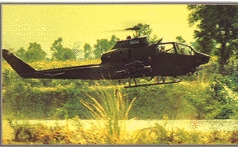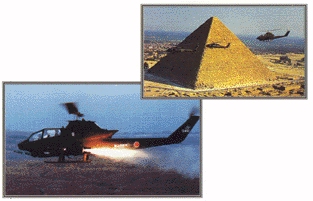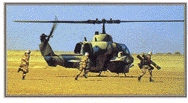AH-1 Cobra

After bringing vertical warfare to Vietnam, the Cobra continues to reach out with lethal guns and missiles. Today the Cobra is flown by Marine pilots who use the speed and power of the AH-1 to fight and win, no matter what the odds. The AH-1 Cobra evolved from the Bell UH-1 Huey and the AH-1G model, which arrived in Vietnam, was the first rotorcraft designed specifically to carry arms to enter combat. New, hard-hitting Cobras are at work today.

The U.S. Army introduced TOW missles to fight tanks. The Marines went a step further with the laser-guided Hellfire missile, fired from many miles away to kill a tank with pinpoint accuracy. Today, Marines use the AH-1W "Whiskey Cobra". A high-tech battlefield is as formidable in many situations as the Army's newer Apache, which came along years later.

The Cobra gunner sits in the front cockpit. At his disposal is a fearsome array of guns and missiles with frightening rapid fire. Early Cobras carried the Minigun, a six-barrel machine gun, which fired at rates of up to 100 rounds per second. Today the slower but harder-hitting M197 20-mm cannon is fitted.
The Cobra is designed to fight down among the trees and bushes where it can lurk undetected until it is time to rear up and strike.
 Although some Marine Cobras carry the deadly Hellfire, most AH-1s rely on the TOW missile. As soon as it has been fired out of its tube, small spring-loaded wings and fins pop out of the missile's body, allowing it to fly to its target.
Although some Marine Cobras carry the deadly Hellfire, most AH-1s rely on the TOW missile. As soon as it has been fired out of its tube, small spring-loaded wings and fins pop out of the missile's body, allowing it to fly to its target.
 When it is out of missles, the Cobra can be rearmed in minutes by a well-drilled ground team. The TOW missiles are prepacked in their launch tubes and are strapped straight onto the helicopter.
When it is out of missles, the Cobra can be rearmed in minutes by a well-drilled ground team. The TOW missiles are prepacked in their launch tubes and are strapped straight onto the helicopter.

FACTS AND FIGURES
The AH-1 first flew on September 7, 1965
Building a Cobra requires 38,500 hours of factory-worker time.
In Operation Desert Storm, four Marine squadrons flew 1,000 missions, including one that destroyed 60 tanks.








